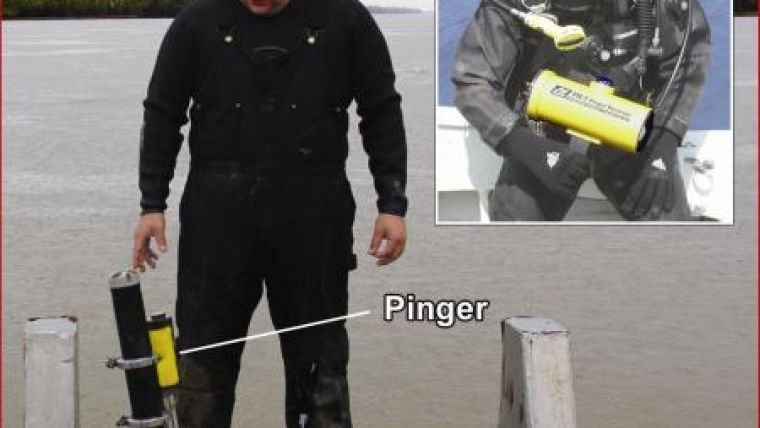Low-frequency Acoustic Pinger
JW Fishers, USA, has recently added a new low-frequency pinger to its line of acoustic devices. The new model has a significantly longer transmission range (3 to 6 miles compared to 2,000-3,000 feet for a conventional pinger), a longer battery life, and a variety of other new features including delayed start which allows the pinger to lie dormant for up to a year before beginning to transmit.
The search for MH370 has put a lot of undersea technology in the media spotlight. Equipment such as the AUV and acoustic pinger are now part of conversations at workplaces and homes. Pingers are underwater signaling devices and a pinger receiver is used either by a diver or attached to an AUV to detect the signal transmitted by the pinger. Putting an acoustic pinger on a black box is only one of the purposes for this device. Pingers have been around for a long time, and they are quietly being used by a diverse group of users.
The US Navy’s Underwater Construction Teams (UCT) routinely use acoustic pingers in their operations. They conduct underwater construction, repair, and demolitions. The teams employ pingers to mark the location of UXO (Unexploded Ordnance) for removal or disposal, and attach them to underwater sites divers need to relocate. The groups choose Fishers MFP-1 multifrequency pingers because each one can be set to transmit a different frequency. Having each pinger broadcasting a unique frequency means many can be deployed in the same general area and individual units can be quickly and easily relocated.
The has one of the most established and well regarded geoscience programmes in the world. R. Wayne Wagner is a post doctoral fellow at the Jackson School of Geosciences at the University of Texas in Austin Department of Geological Sciences. He is developing a better understanding of the affects of land building in coastal Louisiana. The term refers to coastal restoration and hurricane protection projects, which according to a recent study is the new “boom industry” for southeast Louisiana. An important piece of information for his research is knowing how water moves through coastal estuaries. To capture this data Dr. Wagner deploys a Nortek Aquadopp current profiler (ADCP) which must be retrieved to access the stored data. To ensure the profiler doesn’t get lost, Wagner’s team attaches one of Fishers SFP-1 single frequency pingers. This proved invaluable in a recent survey when the retrieval line on the ADCP was cut and a diver had to be deployed with the PR-1 pinger receiver to find it.
Another organization using pingers is the Khalid bin Sultan Living Oceans Foundation, a nonprofit environmental science and ocean research foundation established to help preserve, protect, and restore the world’s oceans and aquatic resources. To gather data on the health of the seas, foundation researchers use a variety of oceanographic instruments. Before deploying an instrument, the SFP-1 pinger is attached. The group also employs Fishers TOV-1 towed video system allowing them to create a visual record of the marine ecosystem.
Image: Commercial diver with recovered ADCP with Fishers SFP-1 pinger attached. Inset photo: Diver with Fishers PR-1 pinger receiver.














